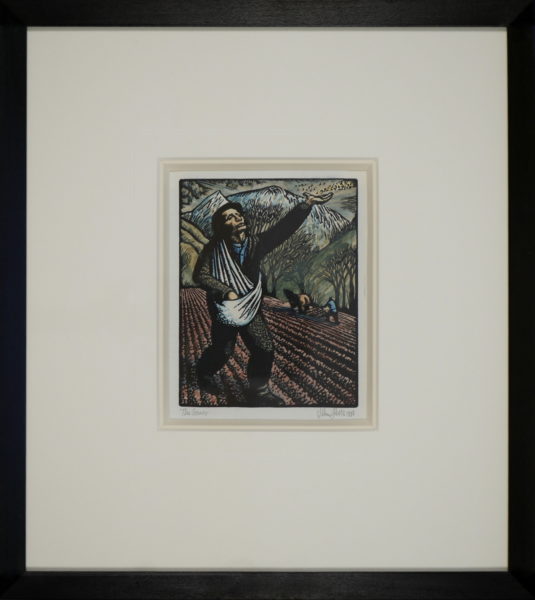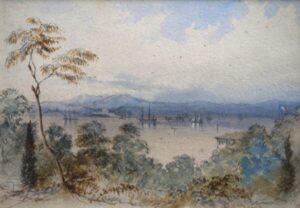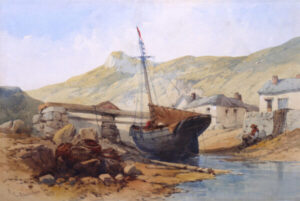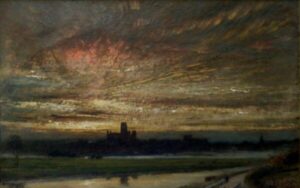Brand
Petts, John (1914-1991)
John Petts was born in Hornsey, London on 10 January 1914, the son of Ernest Petts (1881-1957), a tailor and gentleman's outfitter and an amateur magician and entertainer, and his wife Alice Selina Wade (1892-1930) who ran a florist business and created cakes and treats for children's parties.
John Petts suffered from curvature of the spine, and spent a great deal of his childhood in bed, unable to attend school. After recovering he attended Tollington Grammar School, Muswell Hill, where he developed a passion for art and literature. He was awarded a Saturday morning scholarship at Hornsey School of Art aged 15 and enrolled as a full time student to study painting in 1930. He received a National Diploma in Painting and a two year British Institution scholarship to study at the Royal Academy in 1933, supplementing his income by modelling in the art schools to fund evening classes in printing at the Central School of Arts and Crafts.
The death of his mother in 1930 affected him greatly, and his father's remarriage in 1932 created increasing tension within the family, and he moved out to live with his father's sister Maude (1878-1977), severing all connection with his father and siblings Ernest and Joy until his later years but maintained contact with his younger brother Peter.
It was during this time that he met the artist and writer Brenda Chamberlain (1912-1971) a student at the Academy. They abandoned their studies, married on 11 May 1935 at Kensington Registry Office and set up home at Ty'r Mynydd near Llanllechid, North Wales. They aimed to be self-sufficient and to live by their art, taking any kind of artistic work that came their way. They held their first joint exhibition in Bangor in 1936 and another a year later. He started teaching an adult evening art class at Bangor in 1936 and created wood engravings and linocuts to sell as greeting cards. They bought a hand press in 1937 and founded the Caseg Press, hand printing and colouring greetings cards, bookplates and prints of local scenes and figures, and creating illustrations for literary magazines. In 1939 they were asked to create engravings to illustrate the Welsh Review and were soon contributing prints, short stories and articles for the publication. Petts began to receive regular commissions from the Reverend E. Curig Davies (1895-1981) to illustrate Gwybod, a general knowledge magazine, and his books Storiau am Annibynwyr (1939), and Y Morwr a'r Merthyr (1940). The National Library of Wales also began to buy their prints for its collection from 1939, and by 1940 his skills as an engraver were beginning to be recognised outside Wales.
He was a conscientious objector during the war and was sent to work on farms around the country, leaving Brenda struggling to manage the Press, looking after Peter, his younger brother who had been evacuated from London and working as a mountain guide for the Red Cross.
During the war the poet Alun Lewis (1915-1944) contacted them, and following a meeting in 1941, came up with the idea of producing bilingual broadsheets combining Welsh poetry and engraving. Six 'Caseg broadsheets' were produced during 1941-2, and another 2 were prepared but not published.
Their different experiences during the war and their differing goals and creative rivalry put a strain on their marriage and they separated in 1943 and divorced in 1947. Following their separation, Petts volunteered to serve with the Royal Army Medical Corps' Parachute Field Ambulance resuscitation unit in Europe and the Middle East in 1944. He assisted in the publication of the unit's history, Red Cross Devils and Over the Rhine (1946). He transferred to the Army Educational Corps on accepting a position as lecturer in Artistic Studies at the Army Formation College in Palestine to teach life drawing, wood-engraving, lettering and printing. In 1945 he was made art editor of educational publications in the General Headquarters in Cairo.
His artistic work had come to the attention of the Golden Cockerel Press and he was commissioned to illustrate Gwyn Jones' novel The Green Island in 1945, and he returned to Wales at the end of 1946 to re-establish the Caseg Press. He had met Marjory (Kusha) Miller (1921-2003), an artist and writer, in 1944, and they married in March 1947. They had 2 sons and a daughter, David (born c. 1947), Catrin (born 1950) and Michael (born 1957). They divorced in 1984.
Petts was employed as a designer to develop the Lloyd George Museum at Llanystumdwy in 1947 and installed his printing equipment in the museum, where he designed and printed catalogues and greeting cards for the museum, and Kusha wove bags to be sold in the shop. Jonah Jones, an army colleague helped him re-establish Caseg Press, purchasing new equipment, developing colour printing, and producing a wider range of commercial material. The Press was supplemented by a variety of commissions for illustrations for books such as Alun Lewis' In the Green Tree (1949), Cledwyn Hughes' A Wanderer in North Wales (1949) and Gwyn Williams' Against Women (1953) and In Defence of Women (1960). He also experimented with book publishing, and published Susanna and the Elders, (1948), and Sauna (1949). His next book, 'Woodcuts of Wales' was not completed due to the technical constraints of the press, the ill-health of Jonah Jones, and the increase in purchase tax on luxury goods, and the Caseg Press ended about 1951 due to financial difficulties.
He was appointed Visual Arts Assistant to the Welsh Committee of the Arts Council in 1951 and became Assistant Regional Director in 1952. The family had moved to Aberthaw by 1952. He was elected to the Society of Wood Engravers in 1953 and awarded membership of the Royal Society of Painter-Etchers & Engravers in 1961. He also served on the Arts Council of Great Britain from 1958 to 1961 and was awarded a Churchill Fellowship in 1966. He had hoped to continue engraving in his spare time but found that this work at the Arts Council took up too much of his time, and resigned in 1956, and moved with his family to Lansteffan, where he converted the cowshed into a workshop, to enable him to spend more time creating his own work.
John Petts was appointed lecturer in design and crafts at Carmarthen School of Art in 1957, where he had the opportunity to master stained glass design, a craft which had long held a fascination for him. He saw a close connection between wood engraving and stained glass: 'Wood engraving almost forces you to be a powerful designer because you have strong black lines … Similarly with stained glass, you have to create a holding framework of black shapes in lead and steel which are filled with coloured glass. You discover what you've already learnt in wood-engraving, that your best friend is jet black; the absence of light is necessary for colour to show up.' He rapidly taught himself the techniques of stained glass work whilst keeping one step ahead of his students, but resigned in 1961 to embark on a career as freelance designer and began to gain a reputation in the field of church stained glass.
John Petts was proud to follow in the long tradition of stained glass dating back to the medieval period and was conscious of the fact that the windows would outlast him. He would only use antique mouth-blown glass and exploited the slight variations in colour to create added vibrancy. His aim in all his commissions was to produce work that was personal to the donor, but that would also suit the church in which it was to be installed. He received many commissions, and his work is found in Roman Catholic, Anglican and Nonconformist churches across south Wales, with important works at Gorseinon, Penarth, Llansteffan, Fishguard and Brecon, as well as Brighton and Hove New Synagogue. He instigated the creation and funding of his celebrated window for the 16th Street Baptist Church in Birmingham, Alabama, which was paid for by donations from the people of Wales as a gift to the church after the attack by the Ku Klux Klan that killed four black girls on their way to Sunday school in 1963.
He expressed his faith and theological explorations through his craft and hoped to provoke the viewer to explore and express their own faith. "My concern, first and last, has been what the glass should say, in its own language and its context of worship, proclaiming the News." As a Christian, humility was central to his art, and it was not a vehicle for the artist to flaunt his inner self.
John Petts was a quiet and very religious man, who passionately loved Wales and the Welsh people around him, and remained in Wales for the rest of his life. He married his third wife Anna Brignell in 1985 and moved his studio to an old workhouse in Abergavenny, where he died on 26 August 1991. His archives are at the National Library of Wales.
Author
Morfudd Nia Jones
Collections
National Museum of Wales; National Library of Wales; University College of Wales, Aberystwyth; Newport Art Gallery & Museum; University College, Cardiff; University of Texas, Austin, USA; Friendship House, Birmingham, Alabama, USA; University of Alabama, Birmingham, USA; Welsh Arts Council; American Dental Association, Chicago; Contemporary Art Society for Wales; Derby Art Gallery; University of Hong Kong.



